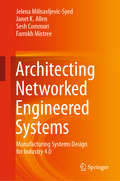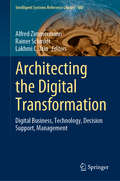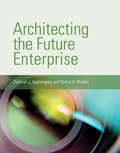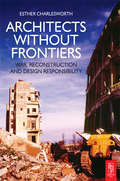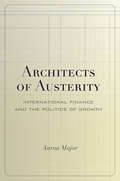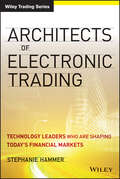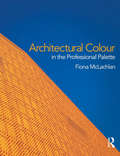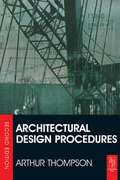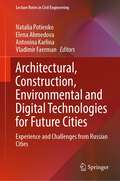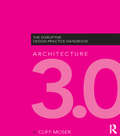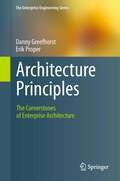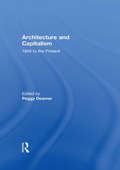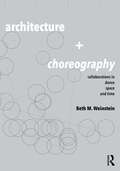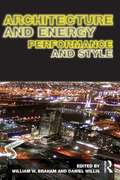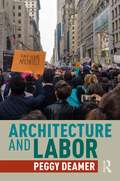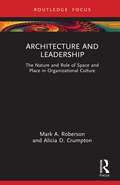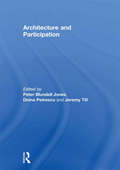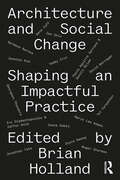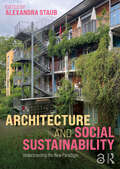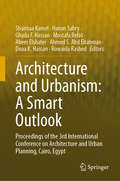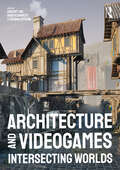- Table View
- List View
Architecting Networked Engineered Systems: Manufacturing Systems Design for Industry 4.0
by Janet K. Allen Farrokh Mistree Jelena Milisavljevic-Syed Sesh CommuriIn this monograph, the authors demonstrate how the integration of adaptability, operability, and re-configurability in the design of complex systems is indispensable for the further digitization of engineering systems in smart manufacturing. Globalization of the customer base has resulted in distributed and networked manufacturing systems. However, current design methods are not suitable to address variations in product design, changes in production scale, or variations in product quality necessitated by dynamic changes in the market. Adaptability, operability, and re-configurability are key characteristics that are necessary to address the limitations of the current methods used to design networked manufacturing systems. In recent years, the digital transformation driving Industry 4.0 has had an enormous impact on globally distributed manufacturing. Digitalisation, the integration of digital technology into networked engineered systems, is increasingly being adopted to respond to changes in the market. This is achieved by means of (a) the concurrent design of adaptable systems, (b) addressing flexibility in design parameters, (c) conducting an operability analysis, and (d) employing a reconfiguration strategy to address faults and variances in product quality and re-establish connectivity among the elements in the system. The design of manufacturing systems in the age of Industry 4.0 is addressed in this monograph. The authors introduce the concept of a ‘smart platform’ and a computational framework for the digitalization of networked manufacturing systems. They also suggest how the framework and techniques in this monograph are applicable beyond the manufacturing domain for architecting networked engineered systems in other industries such as chemical processes and health care, that are being transformed through the adoption of the Industry 4.0 construct.
Architecting the Digital Transformation: Digital Business, Technology, Decision Support, Management (Intelligent Systems Reference Library #188)
by Lakhmi C. Jain Rainer Schmidt Alfred ZimmermannThis research-oriented book presents key contributions on architecting the digital transformation. It includes the following main sections covering 20 chapters: · Digital Transformation · Digital Business · Digital Architecture · Decision Support · Digital Applications Focusing on digital architectures for smart digital products and services, it is a valuable resource for researchers, doctoral students, postgraduates, graduates, undergraduates, academics and practitioners interested in digital transformation.
Architecting the Future Enterprise
by Deborah J. Nightingale Donna H. RhodesEvery enterprise evolves continuously, driven by changing needs or new opportunities. Most often this happens gradually, with small adjustments to strategy, organization, processes, or infrastructure. But sometimes enterprises need to go beyond minor fixes and transform themselves, in response to a disruptive event or dramatically changing circumstances -- a merger, for example, or a new competitor. In this book, enterprise architecting experts Deborah Nightingale and Donna Rhodes offer a framework for enterprise transformation. Successful transformation, they believe, starts with a holistic approach, taking into consideration all facets of the enterprise and its environment rather than focusing solely on one factor -- information technology, for example, or organizational structure. This is architecting the future enterprise: creating a blueprint for what the enterprise will look like after the transformation.Nightingale and Rhodes introduce the ARIES (Architecting Innovative Enterprise Strategy) framework, including a ten enterprise element model and an architecting process model, and show how to apply it, from start to finish. They explain how to create a holistic vision for the future enterprise and how to generate concepts and alternative architectures; they describe techniques for evaluating possible architectures, tools for implementation planning, and strategies for communicating with stakeholders. Nightingale and Rhodes offer real-world examples throughout, drawing on their work at MIT, with an extensive case study of enterprise transformation at a medical device manufacturer. An appendix offers two additional architecting projects. Seven Architecting Imperatives Make architecting the initial activity in transformation. Develop a comprehensive understanding of the enterprise landscape. Understand what stakeholders value and how that may change in the future. Use multiple perspectives to see the whole enterprise. Create an architecting team suited to the transformation challenges. Engage all levels of leadership in transformation. Architect for the enterprise's changing world.
Architecting the Future Enterprise (The\mit Press Ser.)
by Deborah J. Nightingale Donna H. RhodesTwo experts in enterprise architecting lay out a holistic approach to creating a blueprint for future enterprise transformation.Every enterprise evolves continuously, driven by changing needs or new opportunities. Most often this happens gradually, with small adjustments to strategy, organization, processes, or infrastructure. But sometimes enterprises need to go beyond minor fixes and transform themselves, in response to a disruptive event or dramatically changing circumstances—a merger, for example, or a new competitor. In this book, enterprise architecting experts Deborah Nightingale and Donna Rhodes offer a framework for enterprise transformation. Successful transformation, they believe, starts with a holistic approach, taking into consideration all facets of the enterprise and its environment rather than focusing solely on one factor—information technology, for example, or organizational structure. This is architecting the future enterprise: creating a blueprint for what the enterprise will look like after the transformation.Nightingale and Rhodes introduce the ARIES (Architecting Innovative Enterprise Strategy) framework, including a ten enterprise element model and an architecting process model, and show how to apply it, from start to finish. They explain how to create a holistic vision for the future enterprise and how to generate concepts and alternative architectures; they describe techniques for evaluating possible architectures, tools for implementation planning, and strategies for communicating with stakeholders. Nightingale and Rhodes offer real-world examples throughout, drawing on their work at MIT, with an extensive case study of enterprise transformation at a medical device manufacturer. An appendix offers two additional architecting projects. Seven Architecting Imperatives• Make architecting the initial activity in transformation. • Develop a comprehensive understanding of the enterprise landscape. • Understand what stakeholders value and how that may change in the future.• Use multiple perspectives to see the whole enterprise.• Create an architecting team suited to the transformation challenges.• Engage all levels of leadership in transformation. • Architect for the enterprise's changing world.
Architects Without Frontiers
by Esther CharlesworthFrom the targeted demolition of Mostar’s Stari-Most Bridge in 1993 to the physical and social havoc caused by the 2004 Boxing Day Tsunami, the history of cities is often a history of destruction and reconstruction. But what political and aesthetic criteria should guide us in the rebuilding of cities devastated by war and natural calamities? The title of this timely and inspiring new book, Architects Without Frontiers, points to the potential for architects to play important roles in post-war relief and reconstruction. By working “sans frontières”, Charlesworth suggests that architects and design professionals have a significant opportunity to assist peace-making and reconstruction efforts in the period immediately after conflict or disaster, when much of the housing, hospital, educational, transport, civic and business infrastructure has been destroyed or badly damaged. Through selected case studies, Charlesworth examines the role of architects, planners, urban designers and landscape architects in three cities following conflict - Beirut, Nicosia and Mostar - three cities where the mental and physical scars of violent conflict still remain. This book expands the traditional role of the architect from 'hero' to 'peacemaker' and discusses how design educators can stretch their wings to encompass the proliferating agendas and sites of civil unrest.
Architects of Austerity: International Finance and the Politics of Growth
by Aaron MajorArchitects of Austerity argues that the seeds of neoliberal politics were sown in the 1950s and 1960s. Suggesting that the postwar era was less socially democratic than we think, Aaron Major presents a comparative-historical analysis of economic policy in the United States, the United Kingdom, and Italy during the early 1960s. In each of these cases, domestic politics shifted to the left and national governments repudiated the conservative economic policies of the past, promising a new way forward. Yet, these social democratic experiments were short-lived and deeply compromised. Why did the parties of change become the parties of austerity? Studies of social welfare policy in these countries have emphasized domestic factors. However, Major reveals that international social forces profoundly shaped national decisions in these cases. The turn toward more conservative economic policies resulted from two critical shifts on the international stage. International monetary organizations converged around an orthodox set of ideas, and a set of institutional transformations within the Bretton Woods system made the monetary community more central to financial management. These changes gave central banks and treasuries the capacity to impose their ideas on national governments. Architects of Austerity encourages us to critically consider the power that we vest in public financial authorities, which have taken on an ever larger role in international economic regulation.
Architects of Change: Designing Strategies for a Turbulent Business Environment
by Jeremy GhezWhat is the difference between a fire fighter and an architect? One deals with crises as they arise while the other is capable of building something that can withstand all weathers. Using this analogy, Architects of Change provides you with the tools to grasp, leverage and harness the dynamics that shape tomorrow's markets. It encourages you to nurture an entrepreneurial mind-set to transform the way a business – or even an entire industry – operates. Tackling crucial topics related to geopolitics, creative destruction, fake news, resilience and creativity, this book gives you the tools to analyse your environment and future trends in order to reinvent the way you do business. It teaches you how to: · Identify actors of change · Conduct simulations about the future · Assess threats of political instability · Build a strategy for a profitable and sustainable firm amid ongoing uncertainty · Become an architect of change yourself. Containing original interviews with industry insiders, including a world-famous expert on brands and luxury, the former CEO of a major think tank, a thought leader from CISCO, the former chairman of the US National Intelligence Council, and a former chief political scientist of a large Asian bank, this book helps you to understand the type of imagination and creativity this business environment requires not only to survive, but thrive.
Architects of Electronic Trading
by Stephanie Hammer Michael KuhnInsights that can help you improve your technology edgeFeaturing contributions from technology visionaries at leading alternative investors, hedge funds, trading firms, exchanges, and vendors, this book covers current trends in trading technology. The book features interviews with the leaders responsible for the technology that is shaping today's electronic financial markets. You'll hear the views of CIOs, CTOs, and other technology leaders on emerging technologies, innovation in the financial sector, and how technology is enhancing markets in ways other than just speed. Their perspectives on harnessing technology to enhance computing power, reduce time to market, bolster risk management, and much more offer valuable lessons for readers.Includes a wealth of practical insights on how to improve your technology edgeFeatures interviews with leading technology professionals in the financial industry across an array of asset classes and marketsServes as a topical guide to the latest developments, enhancements and applications of technology to tackle trading and risk management challengesIncludes insights from top technology professionals on evaluating and adopting technology solutionsLooks at the effects of technology on finance professionals and their businesses as well as the global finance industry generally
Architects of the International Financial System (Routledge International Studies in Money and Banking)
by Anthony EndresWho were the great thinkers on international finance in the mid-twentieth century? What did they propose should be done to create a stable international financial order for promoting world trade and economic growth? This important book studies the ideas of some of the most innovative economists in the mid-twentieth century including three Nobel Laureates; great thinkers who helped shape the international financial system and the role of the World Bank and the International Monetary Fund. Covering the period from the late 1940s up until the collapse of the fixed US dollar-gold link in 1971, the impact of Hansen, Williams, Graham, Triffin, Simons, Viner, Friedman, Johnson, Mises, Rueff, Rist, Hayek, Heilperin and Röpke is assessed. This outstanding book will prove invaluable to students studying international economics, economic history and the history of economic thought.
Architectural Colour in the Professional Palette
by Fiona McLachlanHow do architects use color? Do they adopt a different strategy or starting point for every project? Do they gradually cultivate individual color palettes, which develop alongside their body of built work? Do they utilize, or are they aware of, the body of theoretical work that underpins the use of color in the past, and forms the basis of most of the color systems commercially available today? Informed by the author’s thirty years in architectural practice and academia, this book investigates, documents and analyzes the work of a number of contemporary architects in order to respond to these questions and provide a clear reference of contemporary color use. The book suggests a holistic approach to the integration of color in architecture; through a series of thematic essays, the text explores and reveals underlying principles in color design and application. Case studies include: AHMM Caruso St John Erich Wiesner and Otto Steidle Gigon/Guyer O’Donnell + Tuomey Sauerbruch Hutton Steven Holl UN Studio. The book provides clear insights into how particular contemporary architects use color confidently and intelligently as an integral part of their design philosophy, in conjunction with their choices of materials and finishes. Offering a stimulating view of the history of color theory, and pragmatic advice to practicing architects, this book will be inspiring to both design professionals and students.
Architectural Design Procedures
by Arthur ThompsonThis book explains how architects obtain and administer work from the moment the contract is signed, to the handing over of the finished building to the client and is an indispensible guide to all architecture students.This second edition has been thoroughly updated and expanded. It now includes significant additions to the section on design constraints, a new section on quality assurance and management and information on new acts and regulations introduced since the publication of the first edition. Other sections on subjects such as the Building Regulations, use of computers and standard forms and letters have been brought up to date.
Architectural, Construction, Environmental and Digital Technologies for Future Cities: Experience and Challenges from Russian Cities (Lecture Notes in Civil Engineering #227)
by Vladimir Faerman Natalia Potienko Elena Ahmedova Antonina KarlinaThis book offers an overview of Russian and international experience in developing the concept of future cities and its practical implementation. The concept of future cities is associated with several important trends. The first trend is the sustainable development of the urban environment and the implementation of eco-friendly technologies and materials in civil construction, industrial and power plants. The harmonious coexistence of the citizens with all forms of nature in the urban habitat becomes a great value. The second trend is the individualization of the aesthetical and architectural image of the future cities. The city's unique flavor based on the blending of the historical legacy and architectural traditions is now as important as the utility of the environment. The third trend is the digitalization of the urban environment with the use of state-of-the-art sensors, information and communication technologies, and data science. The efficiency of operations and services achieved by the extensive use of complex IoT networks becomes a value as well. The last trend is the adaptation of the urban and social environment for individual demands of a community and a person. Individual comfort and safety are now more important than ever before. By addressing these trends, the volume discusses local and international plans, practices, and technologies aimed at the development and implementation of future cities.
Architecture 3.0: The Disruptive Design Practice Handbook
by Cliff MoserThis book provides a definitive guide for the future direction of the practice and profession of architecture. In five parts, Cliff Moser provides you with all the tools and know-how to implement changes that will serve you and your practice in the short, medium and long term. Written at a crucial time for the industry, this is essential reading for every architect.
Architecture Principles: The Cornerstones of Enterprise Architecture (The Enterprise Engineering Series)
by Danny Greefhorst Erik ProperIt can be argued that architecture principles form the cornerstone of any architecture. The focus of this book is on the role of architecture principles. It provides both a balanced perspective on architecture principles, and is the first book on the topic.
Architecture and Capitalism: 1845 to the Present
by Peggy DeamerArchitecture and Capitalism tells a story of the relationship between the economy and architectural design. Eleven historians each discuss in brand new essays the time period they know best, looking at cultural and economic issues, which in light of current economic crises you will find have dealt with diverse but surprisingly familiar economic issues. Told through case studies, the narrative begins in the mid-nineteenth century and ends with 2011, with introductions by Editor Peggy Deamer to pull the main themes together so that you can see how other architects in different times and in different countries have dealt with similar economic conditions. By focussing on what previous architects experienced, you have the opportunity to avoid repeating the past. With new essays by Pier Vittorio Aureli, Ellen Dunham-Jones, Keller Easterling, Lauren Kogod, Robert Hewison, Joanna Merwood-Salisbury, Robin Schuldenfrei, Deborah Gans, Simon Sadler, Nathan Rich, and Micahel Sorkin.
Architecture and Choreography: Collaborations in Dance, Space and Time
by Beth WeinsteinArchitecture and Choreography: Collaborations in Dance, Space and Time examines the field of archi-choreographic experiments—unique interdisciplinary encounters and performed events generated through collaborations between architects and choreographers.Forty case studies spanning four decades give evidence of the range of motivations for embarking on these creative endeavors and diverse conceptual underpinnings, generative methods, objects of inquiry, and outcomes. Architecture and Choreography builds histories and theories through which to examine these works, the contexts within, and processes through which the works emerged, and the critical questions they raise about ways to work together, sites and citations, ethics and equity, control and agency. Three themes frame pairs of chapters. The first addresses disciplinarity through works that critically reflect upon their discipline’s tools, techniques, and conventions juxtaposed against projects that cite or use other art forms and cultural phenomena as source material. The second interrogates space and the role of spatial dispositifs, institutions, and sites, and their hidden and not-so-hidden conditions, as conceptual drivers and structures to subvert, trouble, unsettle, remember. The third asks who and what dances, finding a spectrum from mobilized architectural bodies to more-than-human cybarcorps. Modes of collaboration and the temporalities and life cycles of projects inform bookending chapters.Architecture and Choreography offers vital lessons not only for architects and choreographers but also for students and practitioners across design and performance fields.
Architecture and Energy: Performance and Style
by William W. Braham Daniel WillisDoes energy consumption influence architectural style? Should more energy-efficient buildings look different? Can that "look" be used to explain or enhance their performance? Architecture and Energy provides architects and architectural theorists with more durable arguments for environmental design decisions, arguments addressing three different scales or aspects of contemporary construction. By drawing together essays from the leading experts in the field, this book engages with crucial issues in sustainable design, such as: The larger role of energy in forming the cultural and economic systems in which architecture is conceived, constructed, and evaluated The different measures and meanings of energy "performance" and how those measures are realized in buildings The specific ways in which energy use translates into the visible aspects of architectural style. Drawing on research from the UK, US, Europe, and Asia the book outlines the problems surrounding energy and architecture and provides the reader with a considered overview of this important topic.
Architecture and Health: Guiding Principles for Practice
by Jacob J. Wilhelm Dina BattistoArchitecture and Health recognizes the built environment and health as inextricable encouraging a new mind-set for the profession. Over 40 international award-winning projects are included to explore innovative design principles linked to health outcomes. The book is organized into three interdependent health domains—individual, community, and global—in which each case study proposes context-specific architectural responses. Case studies include children’s hospitals, rehabilitation facilities, elderly housing, mental health facilities, cancer support centers, clinics, healthy communities, healthcare campuses, wellness centers, healing gardens, commercial offices, infrastructure for developing countries, sustainable design, and more. Representing the United States, Africa, Asia, Europe, and Australia, each author brings a new perspective to health and its related architectural response. This book brings a timely focus to a subject matter commonly constricted by normative building practices and transforms the dialogue into one of creativity and innovation. With over 200 color images, this book is an essential read for architects, designers, and students to explore and analyze designed environments that promote health and well-being.
Architecture and Labor: The Economy Of Architecture In Theory And Practice
by Peggy DeamerThrough a collection of 13 chapters, Peggy Deamer examines the profession of architecture not as an abstraction, but as an assemblage of architectural workers. What forces prevent architects from empowering ourselves to be more relevant and better rewarded? How can these forces be set aside by new narratives, new organizations and new methods of production? How can we sit at the decision-making table to combat short-term real estate interests for longer-term social and ethical value? How can we pull architecture—its conceptualization, its pedagogy, and its enactment—into the 21st century without succumbing to its neoliberal paradigm? In addressing these controversial questions, Architecture and Labor brings contemporary discourses on creative labor to architecture, a discipline devoid of labor consciousness. This book addresses how, not just what, architects produce and focuses not on the past but on the present. It is sympathetic to the particularly intimate way that architects approach their design work while contextualizing that work historically, institutionally, economically, and ideologically. Architecture and Labor is sure to be a compelling read for pre-professional students, academics, and practitioners.
Architecture and Leadership: The Nature and Role of Space and Place in Organizational Culture (Leadership Horizons)
by Mark A. Roberson Alicia D. CrumptonFrom cathedrals to cubicles, people go to great lengths and expense to design their living and working environments. They want their spaces to be places where they enjoy being, reflecting who they are and what they care about. The resultant environments in turn become loud, albeit unvocal, leaders for people occupying those corresponding spaces. The design and use of work and living spaces typifies and thematizes expectations for the group. Essentially, the architecture of rooms, buildings and cities creates cultures by conveying explicit and implicit messages. This is evident when people approach and walk into St. Basil’s Cathedral in Moscow, the Forbidden City in Beijing, the Sydney Opera House in Sydney, Australia, the Jewish Museum in Berlin, or the Rothko Chapel in Houston, to name some examples. While leaders oftentimes lack the resources to have their spaces mirror the greatest architectural achievements of the world, they are in a position to use the art and science of architecture, at whatever scale is available, to their advantage. The creative and intentional use of space and place advances and promotes cherished values and enhances organizational effectiveness. This book explores the essence of good architecture and establishes relevant connections for leaders and managers to strategically design and use the organizational workplace and space to support their mission and purpose, and create aesthetically meaningful work environments. It equips leaders to be culturally astute on what defines good architecture and to incorporate principles of beauty in their leadership practices accordingly and will be of interest to researchers, academics, professionals, and students in the fields of leadership, organizational studies, and architecture theory and practice.
Architecture and Participation
by Doina Petrescu Peter Blundell Jones Jeremy TillBringing together leading international practitioners and theorists in the field, ranging from the 1960s pioneers of participation to some of the major contemporary figures in the field, Architecture and Participation opens up the social and political aspects of our built environment, and the way that the eventual users may shape it. Divided into three sections, looking at the politics, histories and practices of participation, the book gives both a broad theoretical background and more direct examples of participation in practice. Respectively the book explores participation's broader context, outlining key themes and including work from some seminal European figures and shows examples of how leading practitioners have put their ideas into action. Illustrated throughout, the authors present to students, practitioners and policy makers an exploration of how a participative approach may lead to new spatial conditions, as well as to new types of architectural practices, and investigates the way that the user has been included in the design process.
Architecture and Social Change: Shaping an Impactful Practice
by Brian HollandArchitecture and Social Change is a timely, and urgently needed, survey of social and environmental justice advocacy in architecture. Spotlighting contemporary design and research practitioners who are creatively leveraging their expertise for social change, this book features interviews with fifteen influential design leaders who are at the forefront of their profession’s efforts to confront pressing challenges like housing insecurity, racial and economic inequality, environmental degradation, and architectural waste. Among the interviewees are Dana Cuff, who, as director of cityLAB, is helping to reshape housing policy in California; Joana Dabaj, cofounder of the design charity CatalyticAction, which empowers refugee children from the Syrian civil war to act as “co-designers” of playgrounds and public spaces in Lebanon; and Ivi Diamantopoulou and Jaffer Kolb of New York City–based New Affiliates, who repurpose, through lively recontextualization, the architectural byproducts of their city’s museum exhibitions and building-performance mockups. These insightful student-led interviews compellingly capture the current moment of soul-searching in both the profession and the academy.An indispensable guide for design students and professionals alike, Architecture and Social Change gathers inspirational stories alongside practical advice for how to navigate a career in architecture while seeking to make a positive impact.
Architecture and Social Sustainability: Understanding the New Paradigm
by Alexandra StaubArchitecture and Social Sustainability shows how we can better design for stakeholder agency, serve historically marginalized populations, and further our theoretical thinking about sustainability writ large.With chapters exploring both the urban and the building scale, this volume examines the design of buildings and urban settings to illustrate how we can create more inclusive and equitable communities through broadening our design approach. Tracing how the professionalization of architecture and urban design has shut out stakeholder input, this book offers a range of methods and theoretical ideas to re-tool the design process for better social sustainability. The book illustrates these concepts through a series of case studies that have worked around systemic inequalities, recaptured stakeholder voices, and helped promote spatial and social justice. Case studies look at reparative urban and landscape design the United States, informal market structures in Nigeria, co-designed housing for low-income communities in India and Brazil, and participatory design for housing, schools, and healthcare facilities in Europe and the U.K. Essential reading for architects and urban designers seeking alternatives to conventional practice, as well as educators and students incorporating social sustainability as a foundational design concept, Architecture and Social Sustainability ties together design thinking and action to show architecture’s potential for social change.The Open Access version of this book, available at http://www.taylorfrancis.com, has been made available under a Creative Commons [Attribution-Non Commercial-No Derivatives (CC-BY-NC-ND)] 4.0 license.
Architecture and Urbanism: Proceedings of the 3rd International Conference on Architecture and Urban Planning, Cairo, Egypt
by Shaimaa Kamel Hanan Sabry Ghada F. Hassan Mostafa Refat Abeer Elshater Ahmed S. Abd Elrahman Doaa K. Hassan Rowaida RashedThis proceedings addresses the challenges of urbanization that gravely affect the world’s ecosystems. To become efficiently sustainable and regenerative, buildings and cities need to adopt smart solutions. This book discusses innovations of the built environment while depicting how such practices can transform future buildings and urban areas into places of higher value and quality. The book aims to examine the interrelationship between people, nature and technology, which is essential in pursuing smart environments that optimize human wellbeing, motivation and vitality, as well as promoting cohesive and inclusive societies: Urban Sociology - Community Involvement - Place-making and Cultural Continuity – Environmental Psychology - Smart living - Just City. The book presents exemplary practical experiences that reflect smart strategies, technologies and innovations, by established and emerging professionals, provides a forum of real-life discourse. The primary audience for the work will be from the fields of architecture, urban planning and built-environment systems, including multi-disciplinary academics as well as professionals.
Architecture and Videogames: Intersecting Worlds
by Vincent Hui Ryan Scavnicky Tatiana EstrinaThis book explores and affirms the emergent symbiosis between videogames and architecture, including insights from a diverse range of disciplines.With contributions from authorities in both architecture and videogame industries, it examines how videogames as a medium have enlightened the public about the built environments of the past, offered heightened awareness of our current urban context, and presented inspiration for the future directions of architecture. A relatively nascent medium, videogames have rapidly transitioned from cultural novelty to architectural prophet over the past 50 years. That videogames serve as an interactive proxy for the real world is merely a gateway into just how pervasive and potent the medium is in architectural praxis. If architecture is a synthesis of cultural value and videogames are a dominant cultural medium of today, how will they influence the architecture of tomorrow?The book is split into seven sections: Cultural Artifacts, Historic Reproduction, Production Technologies, Design Pedagogy, Proxies and Representation, Bridging Worlds, and Projected Futures.
